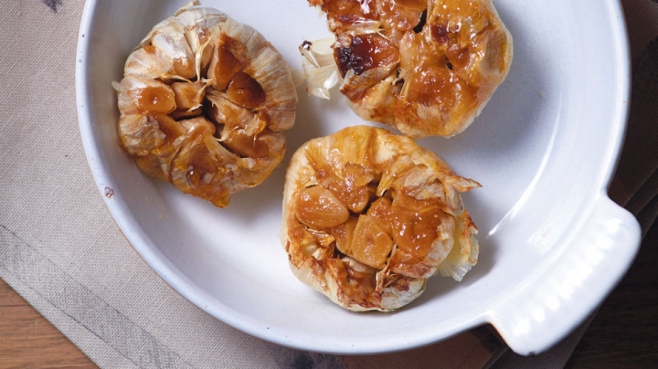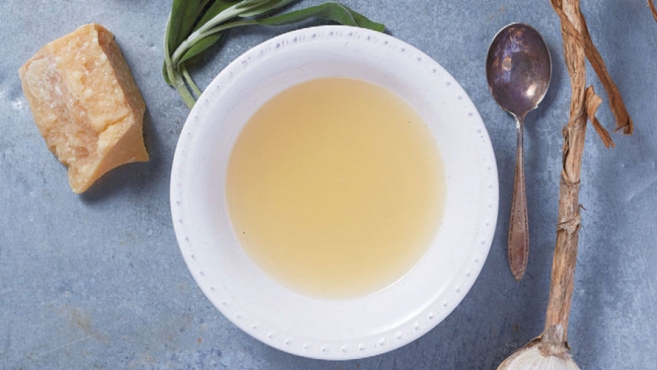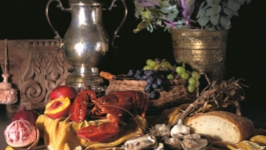Garlic: The Indispensable Allium

The word garlic comes from the old English gār for spear and lēac for leek. Gar refers to the spear-like shape of the bulb. The word fits, more so now when we know how strongly garlic affects our health. Garlic is a warrior; a fierce, sharp-shooting warrior who fights colds, cancers, inflammation, high blood pressure and vampires. She boosts good cholesterol and bone health. She gifts us with hard-to-find vitamins and minerals. On occasion, she reeks. It’s a small price to pay for her guardianship. Here are three ways to incorporate garlic into your diet, in order from most mellow to pungent.
Garlic is a mainstay in my garden and kitchen. I am in complete agreement with Angelo Pellegrini who wrote: “My final, considered judgment is that the hardy bulb [garlic] blesses and ennobles everything it touches—with the possible exception of ice cream and pie.”
—The Unprejudiced Palate (1948)
Allium is the botanical genus for the group of herbs and vegetables that includes chives, garlic, leeks, onions, ramps, shallots and scallions. They add a spicy, pungent note to foods, and when roasted or slow-cooked, the spiciness mellows to a sweetness that enhances any savory recipe.
All alliums are edible, but not all are necessarily tasty; all parts are edible, but the leaves of many species are stringy and tough. For garlic (Allium sativum), the bulb and scapes offer the best flavor and texture. Over time we have selected different garlics for their spiciness, bite, heat and “keeping” quality. This has resulted in the development of two distinct types of garlic: hardneck and softneck.
Hardneck varieties form a stiff “flower” scape in late spring. Removing the scape forces the plant’s energy into forming the underground garlic head instead of bulbils—“baby” garlic cloves that develop at the top of the scape. The optimal time for scape removal is when the scape forms a loop and has not begun to straighten. Don’t throw those scapes away: they make a delicious pesto that freezes well.
You can see the remains of the scape stem in the head of hardneck garlic when you separate the cloves. Hardnecks tend to be spicier and hotter than softnecks. Many aficionados claim that hardneck varieties offer the best flavor and are better for roasting. The cloves tend to be larger with looser skins, making them easier to peel and chop. How long they retain their flavor and firmness depends on the growing season. Hardneck garlic stored in a cool, dry place can last up to six months. But after a wet growing season I have had cloves soften and sprout within two months.
Softneck varieties do not form a hard scape, and in fact seldom flower. Over time, garlic breeders selected non-bolting (non-flowering) softneck varieties. This guarantees that the energy of the bulb is directed toward the production of more cloves instead of a flower stem. The cloves are smaller than in hardneck varieties, but there are more of them. Softneck varieties are known for their milder flavor and for being “keepers,” lasting six to nine months in a cool, dry location. This is the garlic you will find at most supermarkets.
Garlic is further subdivided within the hardneck and softneck designations based on characteristics such as time to harvest, number of cloves, degree of heat/spiciness, heat and cold tolerance and length of storage.
There are two types of softneck varieties:
● Artichokes—flattened head, early harvest
● Silverskins—mild flavor, latest garlic to mature, longest-storing
The hardneck sub-varieties are more numerous:
● Asiatic—spicy
● Creole—heat-tolerant
● Glazed Purple Stripe and Marbled Purple Stripe—closely related to Purple Stripe
● Porcelain—can be intensely sulfurous; mellows with cooking
● Purple Stripe—the “best” roasting garlic
● Rocambole—sweet and complex; the connoisseur’s garlic
● Turban—mild, earliest to harvest
For 17 years I have grown Music, a Porcelain hardneck, in our garden. This year I branched out. My husband and I attended a garlic festival at Jandy’s Farm in Bellefontaine in August where we tasted different garlic cultivars and purchased four highly recommended varieties: Asian Tempest (Asiatic hardneck), Chesnok Red (aka Shvelisi; Purple Stripe hardneck), Peach Mountain (Rocambole hardneck) and Silver White (Silverskin softneck).
In October we planted these new—to us—varieties, along with garlic from our July harvest of 300 heads. We will harvest the garlic at various times starting with Asian Tempest (early June), and ending with Silver White (late July or so), the last variety to mature. The plants will tell us when to harvest. When approximately ⅔ of the leaves are yellow, it is time to dig them up. If all the leaves are brown, that means I waited too long and the heads will have started to open underground. This will result in a loss of flavor and a much shorter storage time.
Regarding Pellegrini’s garlic ice cream and garlic pie: recipes do exist and there are enthusiastic reviews for the garlic ice cream served at The Stinking Rose restaurant in San Francisco…but I think I’ll stick to garlic in savory dishes.







